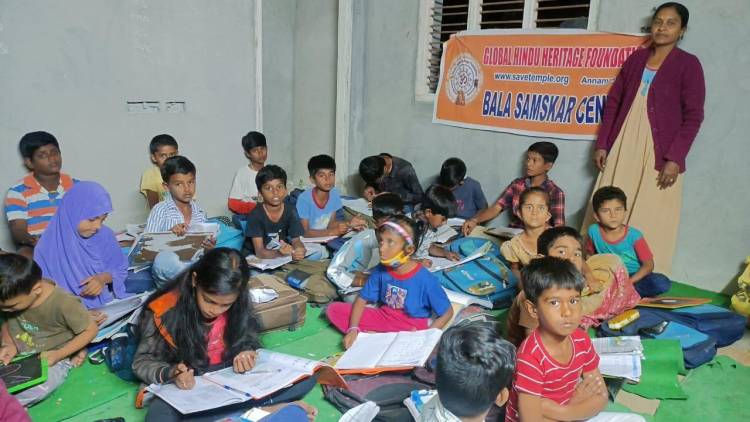[GHHF] Bala Samskar Kendras – Students learned about Yagnam, Vedic Ritual, its method of doing, legend, and benefits.
 Global Hindu Heritage Foundation initiated Bala Samskar Kendras to teach about the richness of Sanatana Dharma, its mission, and the practice of rituals. Yagas and Yagnas are the pillars of Vedic culture. Yagas are an integral part of Sanatan Dharma culture. Performance of these Yagas is beneficial to individuals, community, environment, and the entire cosmos. It is our intention to introduce to our children the ancient history of Yagas conducted by our Rishis and how they benefit us at this time.
Global Hindu Heritage Foundation initiated Bala Samskar Kendras to teach about the richness of Sanatana Dharma, its mission, and the practice of rituals. Yagas and Yagnas are the pillars of Vedic culture. Yagas are an integral part of Sanatan Dharma culture. Performance of these Yagas is beneficial to individuals, community, environment, and the entire cosmos. It is our intention to introduce to our children the ancient history of Yagas conducted by our Rishis and how they benefit us at this time.
Why should the rites of Yagna be performed?
'Yajna' is an ancient Hindu tradition. In Veda it is said Yajna is Vishnu. Yajna can be considered as a form of Vishnu. The word 'Yajna' is derived from the word 'Yaja Devpoojayam'- Divine worship. Different types of Yagnas have been performed in our country since ancient times. The ultimate goal of Yajna is “Idam Na Mama” It is not mine but by whatever this creation has been created, it is customary to offer some of its ingredients to the Lord through Agni Hotra with devotion, thereby attaining our Manobhishta – our desires. Generally, Yajna is performed at fire (homa) accompanied by Vedic mantras. There are many rules and traditions associated with this. Agnihotram is an important part of the Yajna. It is believed that what is offered in the fire of the Yajna reaches all the deities.
Method of Yajna: - Adhwarya is the main priest in Vedic Yajna. All the yajna programs are done under his auspices. He is assisted by many priests and scholars. Vedic mantras are recited. A yajna consists of one or more homa gundas. Many things like ghee, milk and grain are poured into that fire. Yagnas can be performed from a few minutes to a few years. As a part of yagnas. there are yagnas like Ashwamedha Yagam, Putrakameshti Yagam, Rajasuya Yagam, Sarpa Yagam, Vishwajit Yagam, etc.
In the legends: - Iludu, son of Kardama Prajapati, performed Ashwamedha Yagam and regained his manhood. After killing Ravana, Lord Rama crowned Ayodhya and performed Ashwamedha Yaga. We know that Yagnas have been performed for millions of years.
Results of Yajna: - The fumes produced by Yajna Gundam remove the accumulated pollution in the atmosphere and lead to purity. Due to this, the problems of excess rain and lack of rain do not arise. So not only the person performing the Yajna Karma, but the house and surroundings will be improved. All the people around will benefit. Crops grow abundantly. Poultry is good. Infections do not spread. Illnesses do not come. That is why Homas and yajnas are often mentioned in our legends and myths. Germs that harm us are killed. Not only that, but medicine can also be prepared from the ashes of this fire. Ashes that come after performing sacrifices can be used as fertilizer if sprinkled on crop lands. Internal ailments are cured by inhaling this smoke. Without climatic imbalances like lack of rain and excessive sun, the fields will be green, and the country will be prosperous. That's why the elders say to stay in the place where the Yajna is performed and take the remaining ashes after the Yajna. In recent times, those who perform Yajna have become rare. Yagna is heard once in a hundred million times. But, this is incorrect. Even after knowing about the benefits of Yajna, one should come forward to perform the Yajna Karma. Why do we perform Yajnas? We should get rid of the misconception that we are going to the time of kings. If Yajnas are performed, we and those around us will also be happy and healthy. At least some of the pollution accumulated by machines and vehicles can be prevented. Puranas say that by performing Yajnas, the debt to God is repaid.
Your donations are appreciated;
By Zelle: ghhfusaorg@gmail.com
PayPal: savetemples.org
By Check: Or you can send a check payable to GHHF, 14726 Harmony Lane, Frisco, TX 75035.
It is tax-deductible.
By Rupees: call 601-918-711; +91 83096 43979





















 Urgent support needed for Bangladesh Hindus
Urgent support needed for Bangladesh Hindus 







